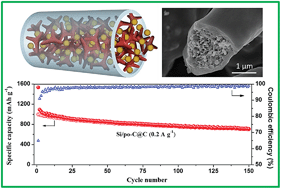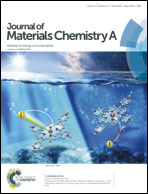Electrospun core–shell silicon/carbon fibers with an internal honeycomb-like conductive carbon framework as an anode for lithium ion batteries†
Abstract
Core–shell silicon/carbon (Si/C) fibers with an internal honeycomb-like carbon framework are prepared based on the coaxial electrospinning technique. For this hierarchical structure, the fiber's core is composed of a porous carbon framework and embedded Si nanoparticles, which is further wrapped by a compact carbon shell. The well-defined Si/C composite anode shows high specific capacities, good capacity retention, and high accessibility of Si in lithium-ion batteries. An initial reversible capacity of 997 mA h g−1 and a capacity retention of 71% after 150 cycles are demonstrated with a current density of 0.2 A g−1. At a higher current density of 0.5 A g−1, a reversible capacity of 603 mA h g−1 can be maintained after 300 cycles. The accessibility of Si in the Si/C anode is up to 3612 mA h g−1 in the 1st cycle. The excellent electrochemical properties are attributed to the hierarchical structure of Si/C fibers. The porous carbon framework in the core region could not only accommodate the volume expansion of Si, but also enhance the conductivity inside these fibers. The compact carbon shell is able to prevent the electrolyte from permeating into the core section, therefore a stable solid-electrolyte interphase can be formed on the fiber surface.


 Please wait while we load your content...
Please wait while we load your content...